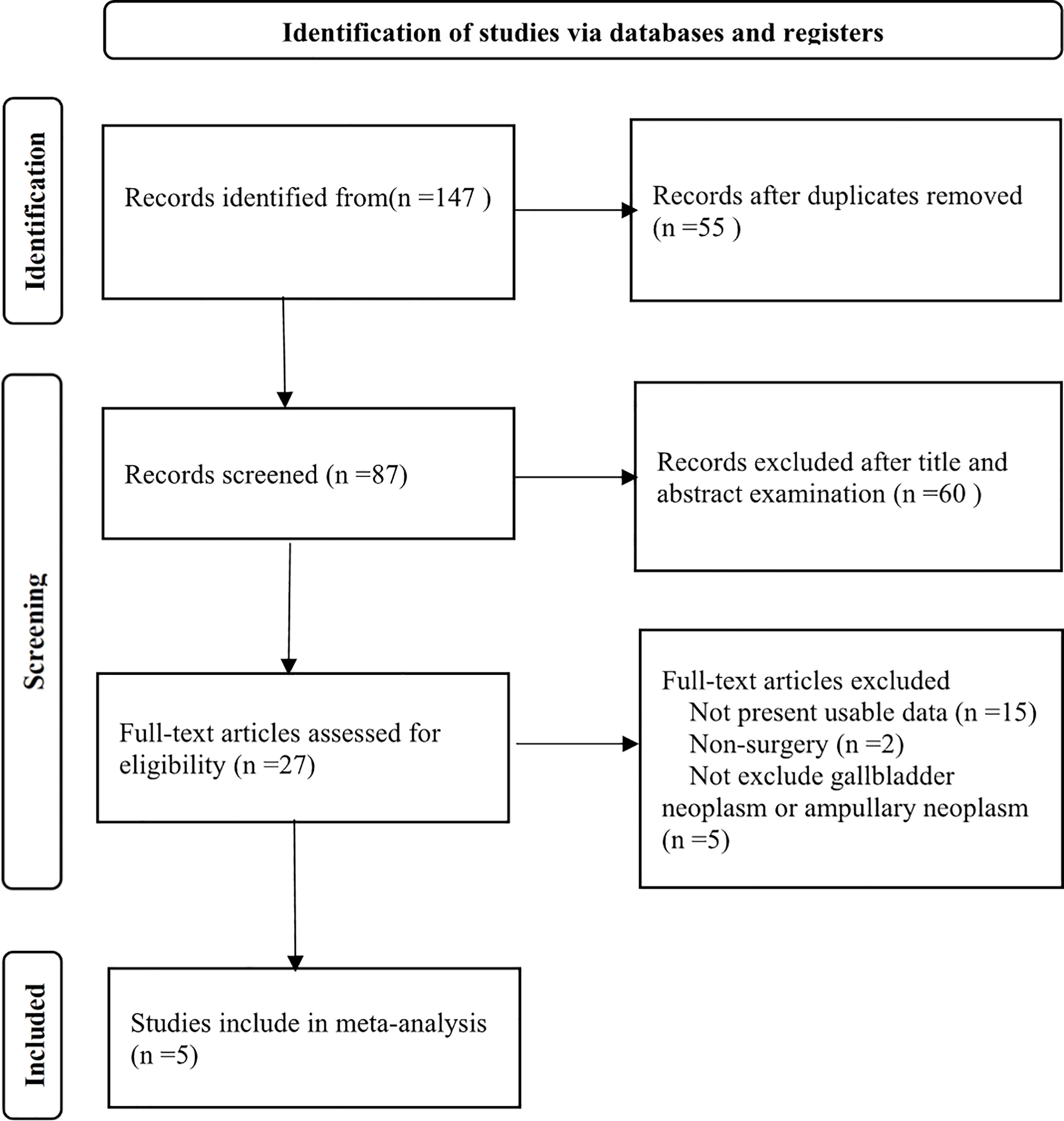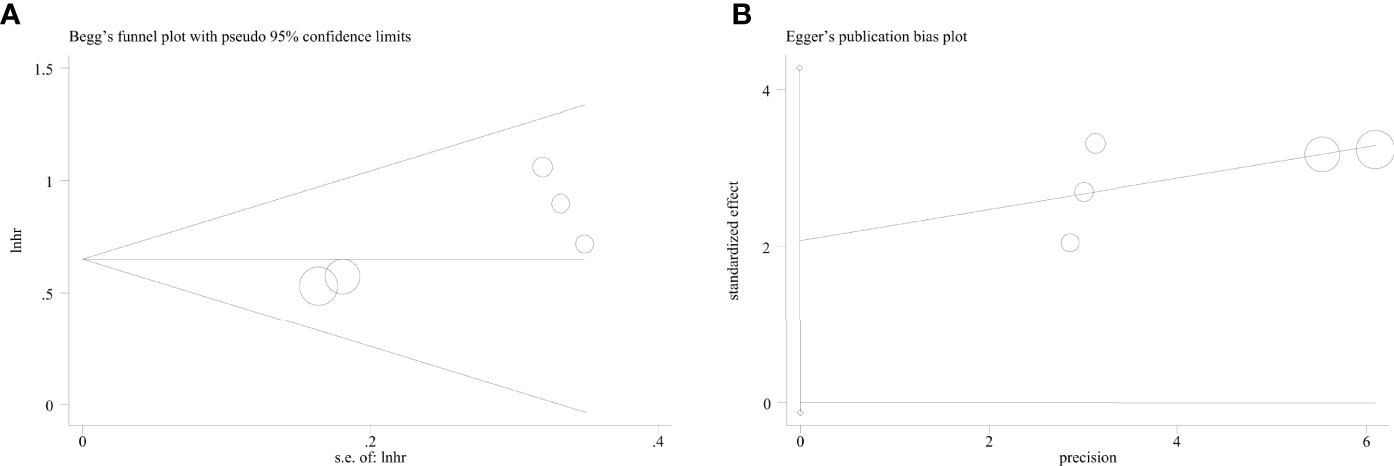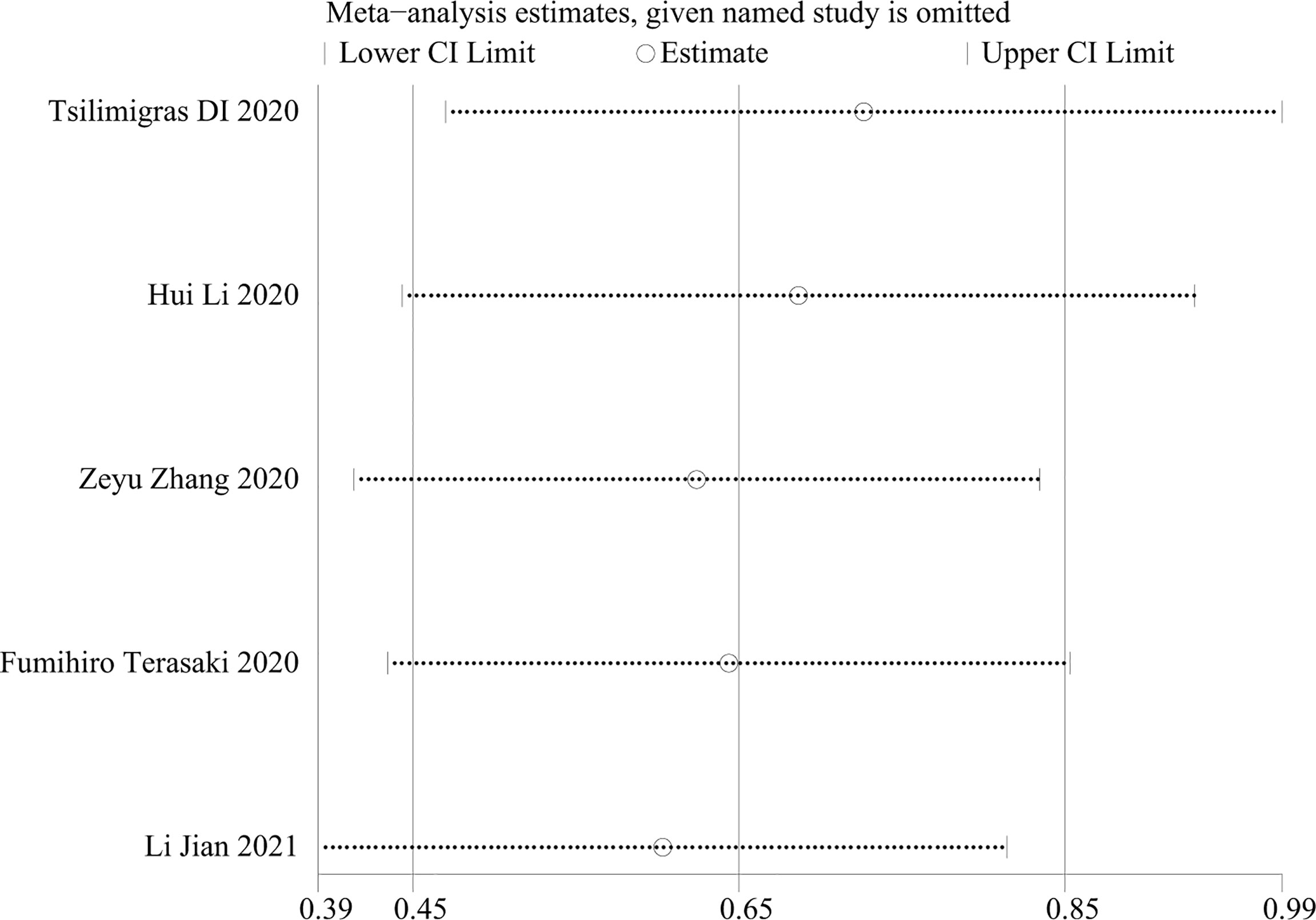- Department of Gastroenterology, The Affiliated hospital of Qingdao University, Qingdao, China
Background: The systemic immune-inflammation index (SII) is a significant prognostic factor for neoplastic diseases. However, the prognostic value of SII in patients with cholangiocarcinoma (CCA) remains unclear. This meta-analysis aimed to investigate the prognostic value of preoperative SII in patients with CCA.
Method: We systematically searched for relevant studies in PubMed, Scopus, EMBASE, Web of Science, PROSPERO, and Cochrane Library databases up to March 22, 2022. Hazard ratios (HRs) and 95% confidence intervals (CIs) were used to estimate the association between SII and survival outcomes, including overall survival (OS) and recurrence-free survival.
Results: Five studies with 1402 patients were included in this meta-analysis to determine the prognostic value of preoperative SII. The results showed that a higher SII was associated with poor OS in patients with CCA who underwent invasive surgery (HR=1.916; 95% CI, 1.566–2.343; Z=6.329; P<0.001). The results were reliable in the subgroup analysis according to country, age, sample size, SII cutoff values, and treatment methods.
Conclusions: A high preoperative SII appears to be an effective and practical method for monitoring survival in patients with CCA.
Systematic Review Registration: International Platform of Registered Systematic. Review and Meta-Analysis Protocols (INPLASY), identifier INPLASY202240015.
Introduction
Cholangiocarcinoma (CCA) refers to a spectrum of invasive adenocarcinomas arising from the biliary tree. Some countries have shown an increasing incidence rate from 0.1 cases per 100,000 to 0.6 per 100,000 over the past 30 years (1, 2). CCA is a rare and aggressive malignancy that is usually asymptomatic in its early stages (3). Surgical resection remains the mainstay of curative therapy for CCA. However, the overall 5-year survival rate ranges from 25% to 40% after surgical resection (4, 5). Postoperative survival is unsatisfactory because of the high risk of complications, recurrence, and metastasis (6) .
Chronic inflammation has been related to various steps of oncogenesis, including cellular transformation, promotion, survival, proliferation, invasion, angiogenesis, and metastasis (7, 8). The systemic immune-inflammation index (SII), a systemic inflammatory marker based on platelet, neutrophil, and lymphocyte levels, has been associated with prognosis in patients with cancers, such as lung, hepatocellular, colorectal, and esophageal cancer (9–12). In these cancer patients, a high SII is associated with shorter overall survival (OS) (13, 14)
However, it remains unclear whether SII is related to the prognosis of CCA. Therefore, this study aimed to investigate the prognostic value of preoperative SII in patients with CCA.
Materials and Methods
Study Guideline and Ethnics
This meta-analysis was performed in accordance with the Preferred Reporting Items for Systematic Reviews and Meta-Analysis guidelines (15). Ethical approval was not required for this meta-analysis because the data were extracted from published studies.
Search Strategy
We systematically searched for relevant studies in PubMed, Scopus, EMBASE, Web of Science, PROSPERO, and Cochrane Library databases up to March 22, 2022. The search terms used were as follows: (cholangiocarcinoma OR bile duct neoplasm OR bile duct cancer OR biliary tract neoplasm OR biliary tract cancer OR cholangiocellular carcinoma) AND (systemic immune-inflammation index OR systemic immune inflammatory index OR SII). Moreover, we manually verified the references of eligible articles.
Selection Criteria
Two authors independently searched for relevant studies and screened the literature using titles and abstracts. The inclusion criteria were as follows: 1) studies investigating the relationship between SII and prognosis of CCA; 2) patients with CCA confirmed by pathological examination; 3) patients who had undergone surgery or invasive surgery; 4) available data of preoperative SII; and 5) patients divided into high and low SII groups according to a cutoff value and followed up over a period of time.
The exclusion criteria were as follows: 1) studies that did not exclude gallbladder or ampullary neoplasm; 2) unclear nonoperative treatment or therapy method; and 3) unavailable hazard ratios (HRs) and 95% confidence intervals (CIs) of survival outcomes.
Data Extraction
Two authors collected data from the studies and resolved conflicts through discussion and consensus. The following information was extracted from these studies: first author, publication year, country, study duration, sample size, follow-up duration, SII cutoff values, and survival outcomes including OS, recurrence-free survival (RFS), and cancer-specific survival (CSS). Considering the confounding factors of each study, HRs were extracted from the multivariate analysis.
Quality Assessment
The Newcastle–Ottawa Scale (NOS) was used to assess the quality of the included studies (16). The NOS includes three parts: patient selection, comparability of research groups, and outcome assessment. The total NOS score ranged from 0 to 9, and studies with scores ≥ 7 were considered to have high quality.
Statistical Analysis
All data analyses were performed using Stata 16.0 software (Stata Corp, College Station, TX, USA). HRs and 95% CIs were directly extracted from each study. When data could not be extracted, Engauge Digitizer 11.1 software was used to extract survival data from the Kaplan–Meier curves, based on the methods described by Tierney et al. (17).
The heterogeneity of the studies was assessed using the chi-square test with the Higgins I2 statistic. If significant heterogeneity existed (I2 > 50%), the random-effects model was selected. When heterogeneity was not present (I2 < 50%), a fixed-effects model was used (18) . Subgroup analysis were performed based on country, sample size, age, SII cutoff values, treatment method, exclusion of chemotherapy, and the total NOS score of these studies. Metaregression analysis (MRA) was carried out to investigate potential impacts of heterogeneity and confounders on outcomes (19). Factors considered variables included sample size, age, SII cutoff values, and NOS. Begg’s funnel plot, Egger’s funnel plot, and sensitivity analysis were used to assess publication bias. Sensitivity analysis were performed to evaluate the overall results after omitting specific studies. Statistical significance was set at a P-value < 0.05.
Results
The database search process is shown in Figure 1. A total of 147 studies were included based on the strategy mentioned previously. Following removal of duplicate studies and initial evaluation by screening titles and abstracts, 27 studies were selected for detailed evaluation. Some studies were excluded for the following reasons: not presenting usable data; nonoperative; and not excluding gallbladder or ampullary neoplasm. Finally, five studies were included in this meta-analysis (20–24) .
The characteristics of these studies are summarized in Table 1. The five included studies comprised 1402 patients, ranging from 128 to 688. All studies reported OS, but only two studies reported RFS (21, 22), and one study reported CSS (20). Three studies were conducted in China (21, 22, 24), one in America (20), and one in Japan (23). The cutoff values were not uniform and ranged from 412.6 to 1450. The treatment method of one study included patients who underwent radical or palliative surgery (24), whereas the treatment method used in the other studies was radical surgery. The NOS scores of the included studies are presented in Table 2.
High SII as an Independent Predictor for Poorer OS and RFS
The results of these studies are shown in Figure 2. The combined results of the five studies showed the following: HR = 1.916; 95% CI, 1.566–2.343; Z=6.329; and P < 0.001. Heterogeneity was not significant; therefore, we used a fixed-effects model (I2 = 0.0%). For RFS (Figure 3), two studies included in the meta-analysis showed median heterogeneity (I2 = 56.3%) with a random-effects model (HR = 1.693; 95% CI, 1.018–2.817; Z = 2.029; P = 0.042). The results suggest that an elevated SII was an independent predictor of poorer OS and RFS in patients with CCA.
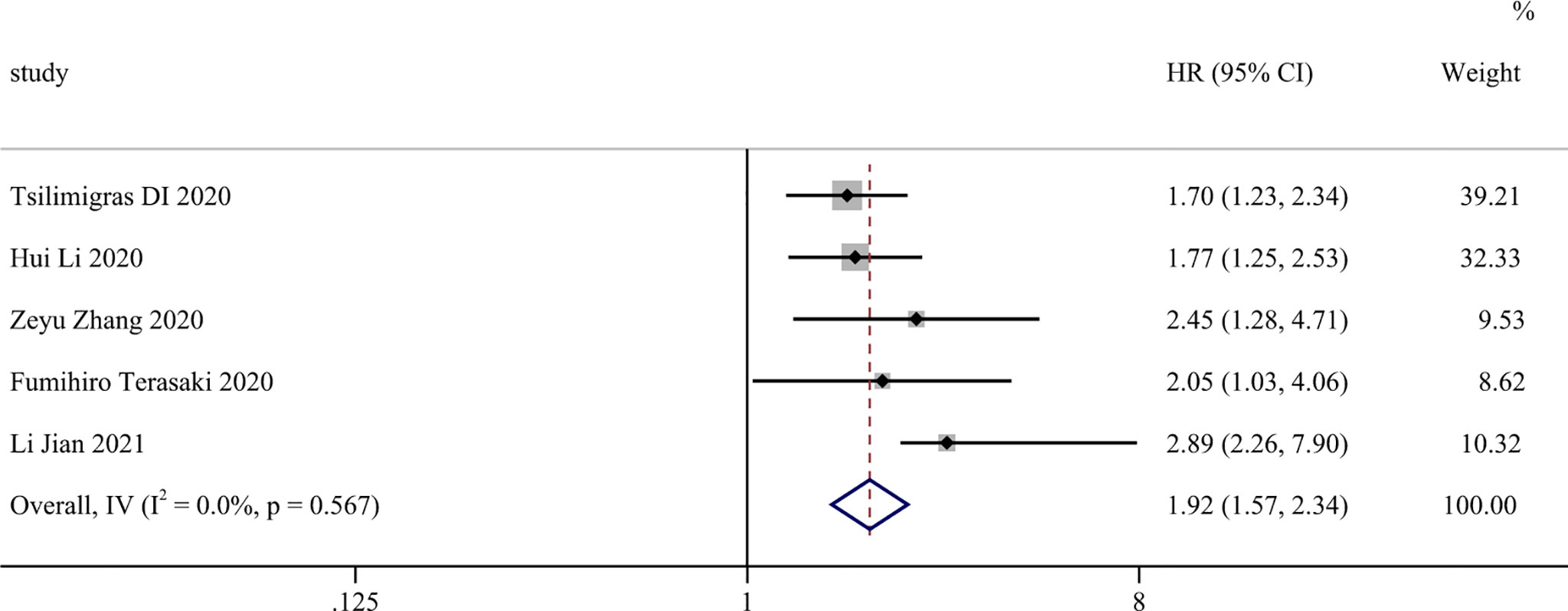
Figure 2 Forest plot of studies evaluating the associations between preoperative SII and OS in cholangiocarcinoma.

Figure 3 Forest plot of studies evaluating the associations between preoperative SII and RFS in cholangiocarcinoma.
Subgroup Analysis and Metaregression Analysis
To detect the prognostic values of preoperative SII in different groups we performed subgroup analysis according to country, age, sample size, SII cutoff values, treatment methods, whether chemotherapy was performed, and the total NOS score of these studies. The subgroup analysis suggested that preoperative SII was still a significant prognostic factor in all subgroups (Table 3). To investigate the reasons for heterogeneity of effect, a metaregression analysis was performed. The results of metaregression analysis are graphically shown as scattered plots (Figures 4A–D). Metaregression analysis was statistically significant (P = 0.025) for sample size in individual studies, whereas age (P = 0.896), the SII cutoff values (P = 0.064), and NOS (P = 0.941) did not explain the demonstrated heterogeneity.
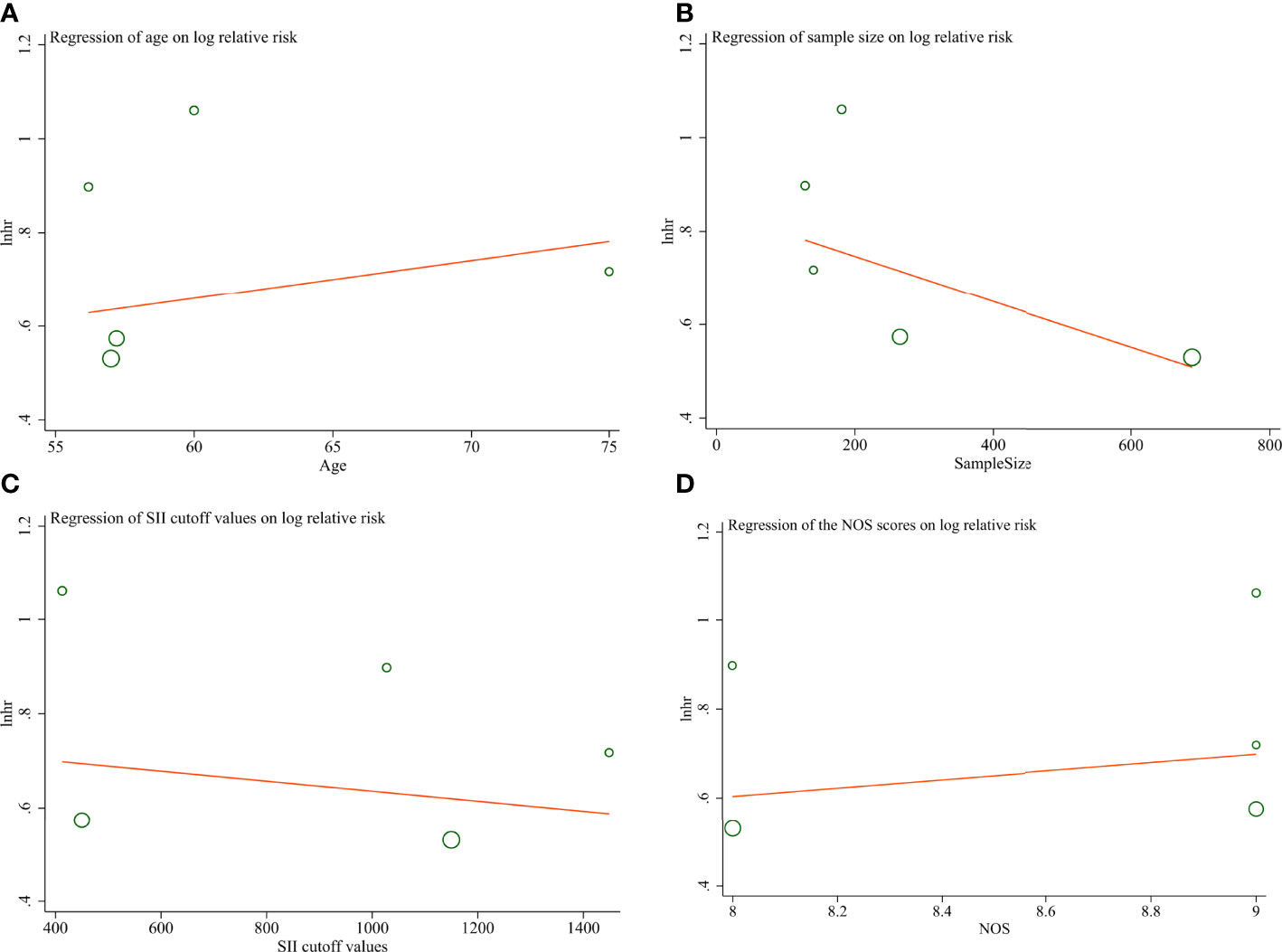
Figure 4 Scattered plots for the metaregression analysis. (A) Age (B) Sample Size (C) SII cutoff values (D) NOS.
Publication Bias
Publication bias was not found in the meta-analysis, as indicated by the symmetry of Begg’s and Egger’s funnel plot (P = 0.058). (Figures 5 A, B). To prove the stability of the meta-analysis, a sensitivity analysis was performed to determine the effect of the individual studies on the overall conclusion. Excluding any individual of these studies did not change the overall results, confirming the reliability of the meta-analysis (Figure 6).
Discussion
The SII is a composite index based on platelet, neutrophil, and lymphocyte counts. Five studies with 1402 patients were included in this meta-analysis to determine the prognostic value of the preoperative SII. The results showed that a higher SII is associated with poor OS in patients with CCA who have undergone invasive surgery. Moreover, subgroup analysis indicated that country, sample size, cutoff values, treatment methods, whether chemotherapy was performed, and the total NOS score of these studies did not influence the reliability of the results. These findings suggest that a high SII before surgery is a good and powerful predictor of poor survival outcomes in patients with CCA.
The SII is a novel index calculated as follows: SII = platelets × neutrophil/lymphocyte counts; these are routinely used in the clinical setting. SII was first used to predict the prognosis of patients with hepatocellular carcinoma (10). Recently, it has been used to predict the prognosis of other diseases as well. Several studies have shown the prognostic significance of neutrophil-to-lymphocyte ratio (NLR) (25, 26) and platelet-to-lymphocyte ratio (27, 28) in patients with CCA. The mechanisms of the prognostic role of the SII in CCA are unclear, however, current understanding is that tumor-associated systemic inflammatory responses involve various inflammatory mediators and cells (29). Neutrophils, which are the most abundant leukocytes in the body, play diverse roles in immune and cancer processes. The levels of neutrophils can be increased by inflammation or cancer induction. Moreover, neutrophis can participate in tumor initiation, angiogenesis, progression, and metastasis (30, 31). In inflammatory conditions, platelets are activated and interact with endothelial cells and leukocytes. In addition, platelets infiltrate the tumor microenvironment to directly interact with cancer cells and increased platelet counts also increase the risk of venous thrombosis in malignancy. Thrombosis is an adverse complication associated with survival of cancer patients (32, 33). In contrast, lymphocytes play an important role in antitumor immune responses (34). Specifically, they affect tumor growth by secreting cytokines, causing cytotoxic cell death, and preventing the growth and migration of cancer cells (35, 36). Thus, an elevated SII is accompanied by high neutrophil and platelet counts and low lymphocyte counts, and hence can be a good predictor for identifying patients with poor prognosis.
According to the NOS, the scores of the included studies were > 7, which can be considered high quality. The overall sample size was 1402, and the heterogeneity of the meta-analysis was 0.0%, indicating that our results were reliable. All studies included in this meta-analysis were retrospective cohort studies. To ensure the stability and reliability of our results, we used several measures. Considering the confounding factors affecting the results in the survival analysis, the HRs and 95% CIs were extracted from the multivariable analysis. Finally, the fixed-effects model was selected based on the low level of heterogeneity in the results.
In conclusion, our study identified the preoperative SII as a sensitive prognostic factor for OS and RFS in patients with CCA. Given the limited number of studies included in the analysis, more clinical trials and retrospective studies are required in the future.
Data Availability Statement
The original contributions presented in the study are included in the article/supplementary material. Further inquiries can be directed to the corresponding author.
Author contributions
XCL and XJ contributed to study conception and design. XCL and JJZ collected the data. XCL, YPJ and XJ analyzed and interpreted the data. XCL wrote the manuscript. YPJ, XGS, LYZ, and XJ made critical revisions to the article. All authors contributed to the article and approved the submitted version.
Funding
This work was supported by grants from the National Natural Science Foundation of Shandong Province [grant numbers ZR202103040311].
Conflict of Interest
The authors declare that the research was conducted in the absence of any commercial or financial relationships that could be construed as a potential conflict of interest.
Publisher’s Note
All claims expressed in this article are solely those of the authors and do not necessarily represent those of their affiliated organizations, or those of the publisher, the editors and the reviewers. Any product that may be evaluated in this article, or claim that may be made by its manufacturer, is not guaranteed or endorsed by the publisher.
References
1. Razumilava N, Gores GJ. Cholangiocarcinoma. Lancet (2014) 383(9935):2168–79. doi: 10.1016/S0140-6736(13)61903-0
2. Valle JW, Kelley RK, Nervi B, Oh DY, Zhu AX. Biliary Tract Cancer. Lancet (2021) 397(10272):428–44. doi: 10.1016/S0140-6736(21)00153-7
3. Banales JM, Marin JJG, Lamarca A, Rodrigues PM, Khan SA, Roberts LR, et al. Cholangiocarcinoma 2020: The Next Horizon in Mechanisms and Management. Nat Rev Gastroenterol Hepatol (2020) 17(9):557–88. doi: 10.1038/s41575-020-0310-z
4. Mazzaferro V, Gorgen A, Roayaie S, Droz Dit Busset M, Sapisochin G. Liver Resection and Transplantation for Intrahepatic Cholangiocarcinoma. J Hepatol (2020) 72(2):364–77. doi: 10.1016/j.jhep.2019.11.020
5. Spolverato G, Vitale A, Cucchetti A, Popescu I, Marques HP, Aldrighetti L, et al. Can Hepatic Resection Provide a Long-Term Cure for Patients With Intrahepatic Cholangiocarcinoma? Cancer (2015) 121(22):3998–4006. doi: 10.1002/cncr.29619
6. Chan KM, Tsai CY, Yeh CN, Yeh TS, Lee WC, Jan YY, et al. Characterization of Intrahepatic Cholangiocarcinoma After Curative Resection: Outcome, Prognostic Factor, and Recurrence. BMC Gastroenterol (2018) 18(1):180. doi: 10.1186/s12876-018-0912-x
7. Singh N, Baby D, Rajguru JP, Patil PB, Thakkannavar SS, Pujari VB.. Inflammation and Cancer. Ann Afr Med (2019) 18(3):121–6. doi: 10.4103/aam.aam_56_18
8. Mantovani A. Cancer: Inflammation by Remote Control. Nature (2005) 435(7043):752–3. doi: 10.1038/435752a
9. Chen JH, Zhai ET, Yuan YJ, Wu KM, Xu JB, Peng JJ, et al. Systemic Immune-Inflammation Index for Predicting Prognosis of Colorectal Cancer. World J Gastroenterol (2017) 23(34):6261–72. doi: 10.3748/wjg.v23.i34.6261
10. Hu B, Yang XR, Xu Y, Sun YF, Sun C, Guo W, et al. Systemic Immune-Inflammation Index Predicts Prognosis of Patients After Curative Resection for Hepatocellular Carcinoma. Clin Cancer Res (2014) 20(23):6212–22. doi: 10.1158/1078-0432.CCR-14-0442
11. Wang C, Jin S, Xu S, Cao S. High Systemic Immune-Inflammation Index (SII) Represents an Unfavorable Prognostic Factor for Small Cell Lung Cancer Treated With Etoposide and Platinum-Based Chemotherapy. Lung (2020) 198(2):405–14. doi: 10.1007/s00408-020-00333-6
12. Zhang Y, Xiao G, Wang R. Clinical Significance of Systemic Immune-Inflammation Index (SII) and C-Reactive Protein-To-Albumin Ratio (CAR) in Patients With Esophageal Cancer: A Meta-Analysis. Cancer Manag Res (2019) 11:4185–200. doi: 10.2147/CMAR.S190006
13. Shui Y, Li M, Su J, Chen M, Gu X, Guo W. Prognostic and Clinicopathological Significance of Systemic Immune-Inflammation Index in Pancreatic Cancer: A Meta-Analysis of 2,365 Patients. Aging (Albany NY) (2021) 13(16):20585–97. doi: 10.18632/aging.203449
14. Bittoni A, Pecci F, Mentrasti G, Crocetti S, Lupi A, Lanese A, et al. Systemic Immune-Inflammation Index: A Prognostic Tiebreaker Among All in Advanced Pancreatic Cancer. Ann Transl Med (2021) 9(3):251. doi: 10.21037/atm-20-3499
15. Page MJ, McKenzie JE, Bossuyt PM, Boutron I, Hoffmann TC, Mulrow CD, et al. The PRISMA 2020 Statement: An Updated Guideline for Reporting Systematic Reviews. BMJ (2021) 372:n71. doi: 10.1136/bmj.n71
16. Stang A. Critical Evaluation of the Newcastle-Ottawa Scale for the Assessment of the Quality of Nonrandomized Studies in Meta-Analyses. Eur J Epidemiol (2010) 25(9):603–5. doi: 10.1007/s10654-010-9491-z
17. Tierney JF, Stewart LA, Ghersi D, Burdett S, Sydes MR. Practical Methods for Incorporating Summary Time-To-Event Data Into Meta-Analysis. Trials (2007) 8:16. doi: 10.1186/1745-6215-8-16
18. Chen Z, Chen R, Zheng D, Su Y, Wen S, Guo H, et al. Efficacy and Safety of Haloperidol for Delirium Prevention in Adult Patients: An Updated Meta-Analysis With Trial Sequential Analysis of Randomized Controlled Trials. J Clin Anesth (2020) 61:109623. doi: 10.1016/j.jclinane.2019.09.017
19. Peng R, Liang X, Zhang G, Yao Y, Chen Z, Pan X, et al. Association Use of Bisphosphonates With Risk of Breast Cancer: A Meta-Analysis. BioMed Res Int 2020 (2020), 2020:5606573. doi: 10.1155/2020/5606573
20. Tsilimigras DI, Moris D, Mehta R, Paredes AZ, Sahara K, Guglielmi A, et al. The Systemic Immune-Inflammation Index Predicts Prognosis in Intrahepatic Cholangiocarcinoma: An International Multi-Institutional Analysis. HPB (2021) 23:S140–1. doi: 10.1016/j.hpb.2020.11.341
21. Li H, Wang JJ, Zhang M, Ren B, Li JX, Xu L, et al. Prognostic Significance of Systemic Immune-Inflammation Index in Patients With Intrahepatic Cholangiocarcinoma Undergoing Hepatic Resection. World J Gastrointestinal Oncol (2020) 12(4):467–82. doi: 10.4251/wjgo.v12.i4.467
22. Zhang Z, Zhou Y, Hu K, Huang Y. Investigating Effects of Preoperative Inflammatory Biomarkers on Predicting Survival Outcomes of Intrahepatic Cholangiocarcinoma After Curative Resection. World J Surg Oncol (2020) 18(1):272. doi: 10.1186/s12957-020-02053-w
23. Terasaki F, Sugiura T, Okamura Y, Ito T, Yamamoto Y, Ashida R, et al. Systemic Immune-Inflammation Index as a Prognostic Marker for Distal Cholangiocarcinoma. Surg Today (2021) 51(10):1602–9. doi: 10.1007/s00595-021-02312-7
24. Li J, Meng S, Bo K, Zhu R, Wang W, Liang R, et al. Relationship Between Systemic Immune Inflammation Index and Postoperative Prognosis of Patients With Hilar Cholangiocarcinoma. Chin J Hepatobiliary Surg (2021) 27(2):106–9. doi: 10.3760/cma.j.cn113884-20200423-00226
25. Omichi K, Cloyd JM, Yamashita S, Tzeng CD, Conrad C, Chun YS, et al. Neutrophil-To-Lymphocyte Ratio Predicts Prognosis After Neoadjuvant Chemotherapy and Resection of Intrahepatic Cholangiocarcinoma. Surgery (2017) 162(4):752–65. doi: 10.1016/j.surg.2017.05.015
26. Tan DW, Fu Y, Su Q, Guan MJ, Kong P, Wang SQ, et al. Prognostic Significance of Neutrophil to Lymphocyte Ratio in Oncologic Outcomes of Cholangiocarcinoma: A Meta-Analysis. Sci Rep (2016) 6:33789. doi: 10.1038/srep33789
27. Kitano Y, Yamashita YI, Yamamura K, Arima K, Kaida T, Miyata T, et al. Effects of Preoperative Neutrophil-To-Lymphocyte and Platelet-To-Lymphocyte Ratios on Survival in Patients With Extrahepatic Cholangiocarcinoma. Anticancer Res (2017) 37(6):3229–37. doi: 10.21873/anticanres.11685
28. Liu D, Czigany Z, Heij LR, Bouwense SAW, van Dam R, Lang SA, et al. The Value of Platelet-To-Lymphocyte Ratio as a Prognostic Marker in Cholangiocarcinoma: A Systematic Review and Meta-Analysis. Cancers (Basel) (2022) 14(2):438. doi: 10.3390/cancers14020438
29. Diakos CI, Charles KA, McMillan DC, Clarke SJ. Cancer-Related Inflammation and Treatment Effectiveness. Lancet Oncol (2014) 15(11):e493–503. doi: 10.1016/S1470-2045(14)70263-3
30. Mahmud Z, Rahman A, Mishu ID, Kabir Y. Mechanistic Insights Into the Interplays Between Neutrophils and Other Immune Cells in Cancer Development and Progression. Cancer Metastasis Rev (2022). doi: 10.1007/s10555-022-10024-8
31. Swierczak A, Mouchemore KA, Hamilton JA, Anderson RL. Neutrophils: Important Contributors to Tumor Progression and Metastasis. Cancer Metastasis Rev (2015) 34(4):735–51. doi: 10.1007/s10555-015-9594-9
32. Stoiber D, Assinger A. Platelet-Leukocyte Interplay in Cancer Development and Progression. Cells (2020) 9(4):855. doi: 10.3390/cells9040855
33. Haemmerle M, Stone RL, Menter DG, Afshar-Kharghan V, Sood AK. The Platelet Lifeline to Cancer: Challenges and Opportunities. Cancer Cell (2018) 33(6):965–83. doi: 10.1016/j.ccell.2018.03.002
34. Farhood B, Najafi M, Mortezaee K. CD8(+) Cytotoxic T Lymphocytes in Cancer Immunotherapy: A Review. J Cell Physiol (2019) 234(6):8509–21. doi: 10.1002/jcp.27782
35. Kitayama J, Yasuda K, Kawai K, Sunami E, Nagawa H. Circulating Lymphocyte is an Important Determinant of the Effectiveness of Preoperative Radiotherapy in Advanced Rectal Cancer. BMC Cancer (2011) 11:64. doi: 10.1186/1471-2407-11-64
Keywords: cholangiocarcinoma (CCA), systemic immune-inflammation index, prognosis, overall survival, meta-analysis
Citation: Liu X-c, Jiang Y-p, Sun X-g, Zhao J-j, Zhang L-y and Jing X (2022) Prognostic Significance of the Systemic Immune-Inflammation Index in Patients With Cholangiocarcinoma: A Meta-Analysis. Front. Oncol. 12:938549. doi: 10.3389/fonc.2022.938549
Received: 07 May 2022; Accepted: 13 June 2022;
Published: 07 July 2022.
Edited by:
Mark De Ridder, Vrije University Brussel, BelgiumReviewed by:
Artur Rebelo, University Hospital in Halle, GermanyGenglong Liu, Guangzhou Medical University Cancer Hospital, China
Muhammad Hashim Hayat, Vanderbilt University Medical Center, United States
Copyright © 2022 Liu, Jiang, Sun, Zhao, Zhang and Jing. This is an open-access article distributed under the terms of the Creative Commons Attribution License (CC BY). The use, distribution or reproduction in other forums is permitted, provided the original author(s) and the copyright owner(s) are credited and that the original publication in this journal is cited, in accordance with accepted academic practice. No use, distribution or reproduction is permitted which does not comply with these terms.
*Correspondence: Xue Jing, amluZ3h1ZUBxZHUuZWR1LmNu
 Xue-chun Liu
Xue-chun Liu Yue-ping Jiang
Yue-ping Jiang Xue-guo Sun
Xue-guo Sun Jian-jian Zhao
Jian-jian Zhao Ling-yun Zhang
Ling-yun Zhang Xue Jing
Xue Jing